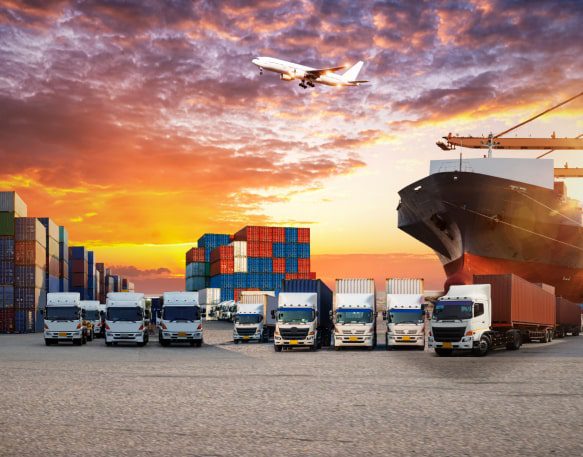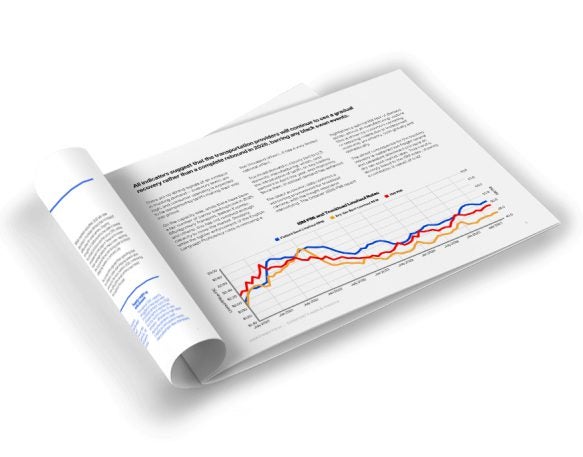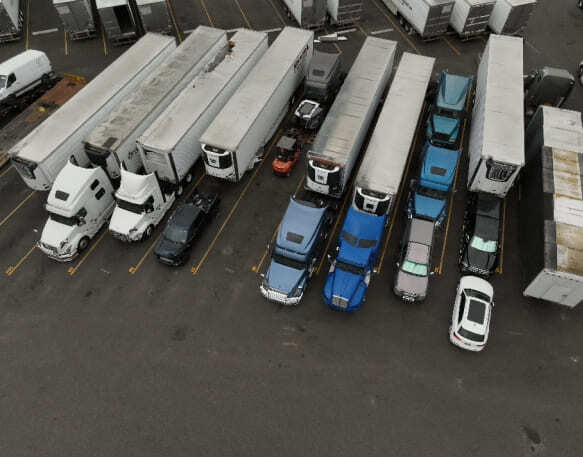However, now that the supply chain is facing serious issues in the wake of the COVID-19 pandemic and other international crises, it’s on the forefront of everyone’s minds.
But what exactly is the supply chain and how does it work? Even for those who play a critical role in its day-to-day functioning — such as those in the trucking industry — the supply chain can be confusing. In this primer, we’ll cover everything you ever wanted to know about the trucking supply chain, including how it works, the role of truckers within it, the basics of supply chain management and optimization, and how you can make the trucking supply chain work for you.
Understanding the supply chain
Supply chains are systems that allow for the global flow of commerce. They connect organizations to producers through a network that consists of three main parts: purchasing, manufacturing, and transportation.
Understanding how exactly the supply chain works can be confusing, so it’s useful to imagine a simple example. Imagine the journey that flowers would make from a florist to a customer. First, a flower grower needs to plant the seeds and grow the orchids in the first place. Then a business buys the orchids from the floriculturist before transporting them to a warehouse and selling them to a florist (each a key step in the supply chain). Then the florist sells the orchids to customers.
While goods have always needed to travel from one place to another to sell to customers, creating a supply chain in one form or another, the last few decades have seen a huge increase in the volume of goods that travel. That’s all thanks to increased globalization with the American manufacturing base increasingly moving overseas in pursuit of lower labor costs. Those lower labor costs have led to lower product costs for consumers, but they have also massively expanded the supply chain and created more spaces where things can go wrong. This is something we are witnessing right now with the large-scale impact of the COVID-19 pandemic. We are seeing today that when there are delays in these factories abroad the entire supply chain is affected.
Going back to the basics of the supply chain, once a product is purchased and manufactured, the next step in the process is shipping. This stage typically takes place over water. With the advent of large shipping containers, the cost of moving freight across the ocean was drastically reduced, further enabling globalization and increasing the pressure on the supply chain to function optimally. Nowadays around 90% of globally traded goods travel by sea. These include everything from smartphones to imported fruits and vegetables.
After goods make their sea journey and arrive in ports where they’re unloaded, it’s time for the last major element of the supply chain: transportation. That’s where trucking comes in. Truckers need to deliver all of those manufactured goods from the warehouses where they’re stored to the retailers who will sell them. Only then can consumers get the products they need into their hands.
The essential role of supply chain truck drivers
There’s no doubt that truckers form a critical part of the supply chain. In the U.S. alone, the trucking industry moves 10.23 billion tons of freight, or 72.5% of the country’s total domestic tonnage, each year. Without the hard work of the more than 7.6 million employees — including over 3.3 million professional drivers — who make up the trucking industry, the supply chain (and the economy) would come to a standstill.
Luckily, these employees and truckers work hard to keep that from happening. Even at the height of the pandemic when people across the country were facing massive shortages, truckers continued to deliver goods as quickly as possible to help alleviate the struggles. Despite this continual hard work, truckers are unfortunately often blamed when something goes wrong in the supply chain as a whole.
We’re watching that play out right now as the world navigates its current supply chain bottlenecks and a lot of undue pressure is put on a supposed truck driver shortage. This scapegoating means many leaders stop the investigation there before interrogating what other issues in the global supply chain might be causing problems before the goods even reach the trucks in the U.S.
While there’s no doubt that the trucking industry is currently actively seeking committed, qualified drivers who want to do this important work, the constant dialogue around these shortages simply serves to deflect attention from the other areas in the global supply chain that are causing problems.
It’s important that truck drivers not be disheartened by the media’s focus on the trucking industry causing problems in the supply chain. Instead, they should remember that they are the beating heart of the nation and the economy and that without them, so much that we take for granted would be lost.
The basics of the supply chain: What is supply chain management?
Supply chain management is what happens behind the scenes of the supply chain. It consists of supply planning, product planning, demand planning, sales and operations planning, and supply management.
The goal of supply chain management is to design and implement the most cost-effective and efficient supply chain process possible — one that is both competitive and resilient to unexpected challenges and changes.
Why is supply chain management important?
Any impact on the supply chain — whether positive or negative — can have a resounding effect on an organization, potentially affecting both customer happiness and return on investment (ROI). Supply chain management is important because it helps to minimize this impact while also helping businesses be more competitive in the market.
Generally speaking, supply chain management is essential to ensure that goods reach consumers efficiently. When it comes to the trucking supply chain in particular, supply chain management focused on design and optimization is particularly important. That’s because trucking is what’s called a “diseconomy of scale.”
What does that mean? In general, when you purchase higher quantities of a product, the per-unit cost goes down. This is something you’ve likely seen in your daily life with larger packages of a certain product having a lower per-unit cost than their smaller counterparts. While logical, this isn’t the case in situations with diseconomies of scale. In trucking, more loads on a given lane could actually lead to a higher cost per load, instead of a lower one.
That’s not great news for carriers for whom the matter of taking on extra loads can be complicated and who typically try to distribute their services across balanced networks where significant adjustments can prove challenging. Without having a proper procurement process in place that accounts for tight market conditions, increased demand and market pressure can disrupt those networks and lead to decisions that end up costing carriers if they decide to take on more freight.
Planning ahead through supply chain management and optimization can help ensure that carriers don’t accidentally get caught in a costly situation. It can also help carriers minimize overhead and increase profits by identifying and addressing weaknesses in their networking model.
How to optimize your trucking supply chain
Supply chain optimization involves analyzing your operations and comparing your performance and rates against the market rates to determine where you’re excelling and where your model needs improvement. It begins with understanding your market needs and what matters most to your business. From there you can start using data to refine strategies and make adjustments to your supply chain.
The best place to find that data is through DAT iQ, a data and analytics tool from trucking industry leader DAT.
DAT iQ processes over $1 trillion in real freight transactions to deliver the most accurate data about market rates. DAT iQ uses both under contract and spot market data and never includes bids or negotiation rates in their calculations to ensure the data is as accurate as possible. DAT iQ then uses that data to deliver real-time analysis and rates across all lanes.
To optimize your trucking supply chain, you’ll want to look at the data on your specific lanes and in your markets to see how you compare. With DAT iQ, you can generate reports and analyses tailored to your specific supply chain. You can access these through intuitive dashboards, visualizations, and charts to gain insight into the market conditions and other factors that are affecting your supply chain strategies.
When it’s time to plan ahead, DAT iQ is again a great source of information. Leveraging information from DAT’s global shipping partners, DAT iQ offers the most accurate forecasting information in the trucking industry — including information based on the data sets most relevant to your operation. From there, you can benchmark your rates, track rate fluctuations both over time and based on precise geographic markers, and forecast your rates as much as 52 weeks in advance with double the accuracy of any other prediction model.
Once you’re armed with both data and DAT iQ’s actionable insights, you can identify inefficiencies within your own supply chain and take action to optimize your operation.
Start optimizing your supply chain today!
Do you want to make your trucking supply chain as cost-effective and efficient as possible? DAT iQ has all the tools you need to start transforming your strategies. Check it out today!




